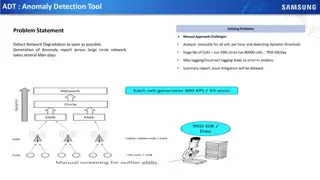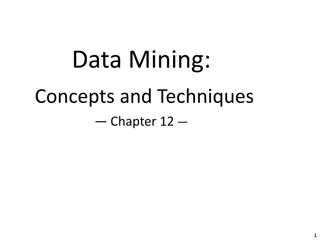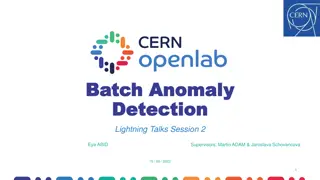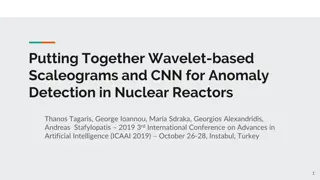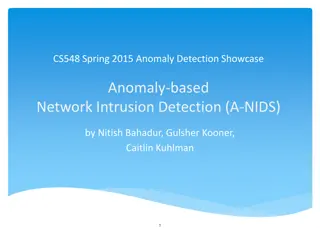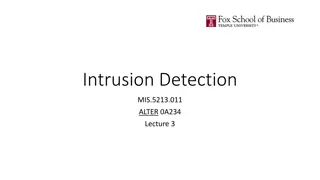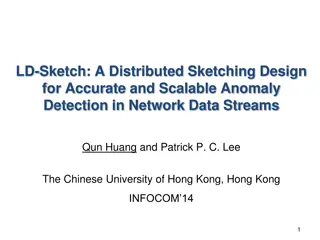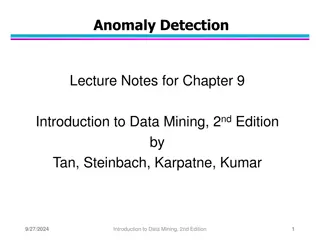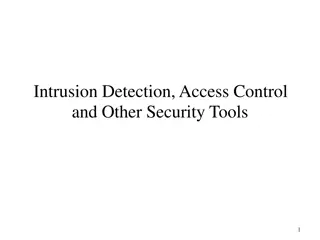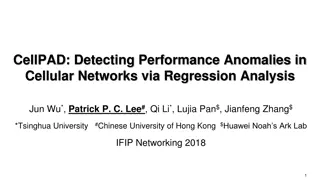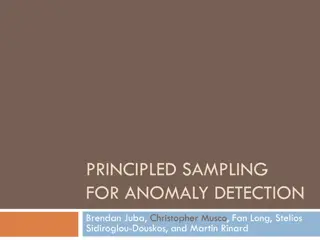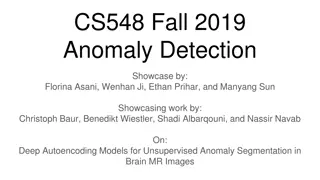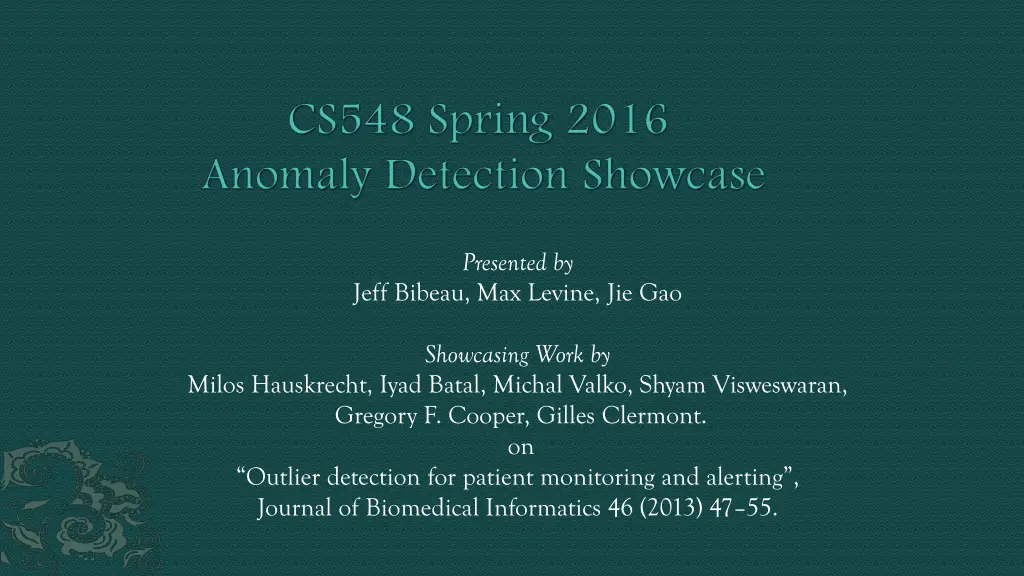
Innovative Patient Monitoring Techniques and Outlier Detection
Discover groundbreaking techniques in patient monitoring and outlier detection to improve healthcare outcomes and prevent medical errors. Explore the use of electronic health records and conditional outlier detection for patient-specific alerts, revolutionizing healthcare practices.
Download Presentation

Please find below an Image/Link to download the presentation.
The content on the website is provided AS IS for your information and personal use only. It may not be sold, licensed, or shared on other websites without obtaining consent from the author. If you encounter any issues during the download, it is possible that the publisher has removed the file from their server.
You are allowed to download the files provided on this website for personal or commercial use, subject to the condition that they are used lawfully. All files are the property of their respective owners.
The content on the website is provided AS IS for your information and personal use only. It may not be sold, licensed, or shared on other websites without obtaining consent from the author.
E N D
Presentation Transcript
Presented by Jeff Bibeau, Max Levine, Jie Gao Showcasing Work by Milos Hauskrecht, Iyad Batal, Michal Valko, Shyam Visweswaran, Gregory F. Cooper, Gilles Clermont. on Outlier detection for patient monitoring and alerting , Journal of Biomedical Informatics 46 (2013) 47 55.
Kohn LT, Corrigan JM, et al. To err is human: building a safer health system. National Academy Press; 2000. Starfield B. Is US health really the best in the world? JAMA 2000;284(4):483 5. Thomas EJ, Studdert DM, Newhouse JP. Costs of medical injuries in Utah and Colorado. Inquiry 1999;36:255 64. Classen DC, Resar R, Griffin F, Federico F, Frankel T, Kimmel N, et al. Global Trigger Tool shows that adverse events in hospitals may be ten times greater than previously measured. Health Aff 2011;30:581 9. Levinson DR. Adverse events in hospitals: national incidence among Medicare beneficiaries. Contract no.: Department of Health and Human Services, Office of the Inspector General, Report number OEI-06-09-00090; 2010. Landrigan CP, Parry GJ, Bones CB, Hackbarth AD, Goldmann DA, Sharek PJ. Temporal trends in rates of patient harm resulting from medical care. New Engl J Med 2010;363:2124 34.
Due to errors, medical treatment is not always consistent with the condition of a patient Proper treatment? Was treatment Omitted? Proper testing? Was testing Omitted? Medical errors can have fatal consequences Preventable injuries affect 2% of patients (1999 study) 6% error rate that led to adverse events (2010 study)
Current tools are based on domain knowledge Rule error detection Expert input is time consuming Experts can t cover all possible outcomes Rules based methods are difficult to tune
Detect outliers in patient care based on patient condition Conditional outlier detection Used to generate patient specific alert Advantages No expert input Use past cases EHR (Electronic Health Records) to develop outlier detection Alert coverage is broad
Post Surgical Cardiac Patients Training Set 2878 cases from 2002-2004 Test Set 1608 cases from 2005-2006 EHR contain Time series of lab tests, medical orders, procedures, diagnoses, events Patient state instance linked to management actions
Model Building Stage Learn proper patient care from database of Electronic Health Records(EHR) Model Application Stage Apply learned models to specific patients to determine if they receive proper care
Outlier is an observation that deviates largely from other observations given same data CAD looks to find unusual outcomes for a subset of (response) attributes given the remaining (context) attributes In this case the response are actions and the context is patient history
?is information about current patient state ? is a patient management action ???? ? ,? = 1 ? ? ? High level anomaly if low probability of action based on patient state is low
Segmentation Split management actions and patient information into distinct time points 51492 patient state instances 30828 training 20664 test
Represent data as fixed length feature vectors Lab tests 28 features summaries test info Medication order 4 features Procedure 3 features
Discriminative projection f(x) induced by Support Vector Machine(SVM) to predict conditional probability Build individual models for different actions to reduce variance and increase accuracy Features are chosen in groups by learning SVM and adding features that improve the area under the ROC curve (AUC) Used 197 lab omission models, 278 medication omission models, and 231 medication commission models
Each time period has an alert score based on the severity Based on anomaly scores of consecutive times First is how surprising an action is based on previous patient state Second is how is surprising in the next time period Trigger alert if above set threshold ?????(??,?? 1) = min[????(?? 1,?? 1),????(??,?? 1)].
4870 alert candidates 222 alerts were selected Skewed toward higher scores
Alert 1. Order levothyroxine: The patient was on levothyroxine prior to surgery. An order for one week of levothyroxine was sent to the pharmacy system. The patient eventually had to stay in the hospital longer but levothyroxine was not re-ordered. The system generated an alert and recommended re-ordering levothyroxine. Alert 2. Order potassium: The patient was in cardiogenic shock. The patient was on vasopressors and inotropes, as well as furosemide. The potassium levels were low. The system generated an alert and recommended supplementing potassium.
Alert 3. Order heparin: The patient had undergone cardiac surgery 2 days ago and would, under normal circumstances, be given heparin after surgery. However, the patient was taken to surgery again for persistent postoperative bleeding at the time the alert was generated. This information was present only in the progress notes and was not available to the system; hence the system generated an alert and recommended continuing heparin. Alert 4. Discontinue warfarin: After heart valve replacement surgery, the patient was on heparin and was being transitioned to warfarin. The system generated an alert and recommended discontinuing warfarin. At the time of the alert, the INR (used to measure the intensity of anti-coagulation) was high, but not high enough for patients who have a mechanical valve.
The heights of the bins show true alert rates for alerts core intervals of width 0.2. Red line were fitted using linear regression.
This proposed outlier-based methodology can generate useful alerts with true alert rates ranging from 0.25 for weak alerts corresponding to 0.66 for stronger alerts. In general, high frequency and low quality alerts can lead to alert fatigue and subsequently to high override rates. This evaluation study was conducted offline using retrospective data and hence it did not account for all aspects of the deployed alerting systems. True alert rates are positively correlated with alert scores. This suggests the adjustment (control) of the alerting system toward desired true alert rates may be possible.

